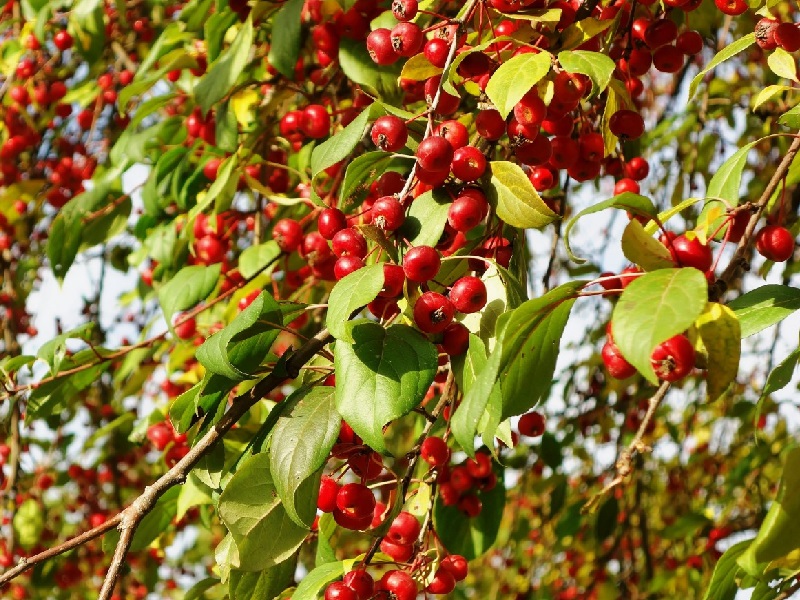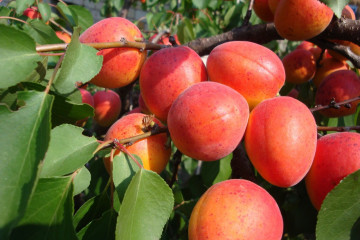Apple-tree Berry or Siberian: variety description
Content:
Among the variety of apple varieties, there are plants that are not grown for harvest. The purpose of planting them is the aesthetic beauty that the tree carries. One of these representatives is the Yagodnaya apple tree. The plant has earned its popularity due to its unusual appearance, long flowering, abundance of fruiting, which makes it possible to embody the most interesting ideas for landscape design.
History and homeland
The origin of the Yagodnaya apple tree is not exactly known, but according to several sources, China is considered the birthplace of the variety. This culture belongs to wild varieties, there are many varieties. In another way, the apple tree is also called: Sibiryachka, Cherry apple tree.
Advantages and disadvantages
The popularity of the Berry apple tree is due to the mass of advantages, thanks to which it is a leader among other ornamental species.
Among the main advantages, it is important to note:
- high frost resistance;
- unpretentiousness to soil composition;
- undemanding care;
- tendency to regular fruiting;
- increased immunity to diseases, pests;
- decorativeness of the tree.
In addition to the positive characteristics, the Berry variety also has disadvantages - small fruitiness, tastelessness. Apples are cultivated more for decorative purposes than for harvesting.
Description and characteristics of the apple tree Berry
Choosing the Sibiryachka variety, you need to take into account its features and characteristics.
Tree size and annual growth
The Yagodnaya apple tree can grow up to 10 m in height. There are specimens that form a bush, others differ in a curved trunk. The plant has an umbrella-shaped crown, which consists of elongated branches. The plant is decorated with elliptical or oblong-ovoid foliage, up to 8-10 cm in length. The leaf plate is painted in a rich green color, which becomes beautiful with the onset of autumn, acquiring a bright color.
Winter hardiness and disease resistance
The Siberian variety boasts high winter hardiness. Even in the most severe winter, it does not require shelter, as it is able to withstand a temperature drop of up to -5-6 degrees.
The plant is not afraid of diseases typical of fruit crops. It is also resistant to harmful insects. However, when growing an apple tree, it is important to carry out preventive measures using time-tested protective equipment.
Features of ripening and fruiting
If you adhere to proper care and carry out all procedures in a timely manner, you can consistently get a rich fruit harvest. The plant begins bearing fruit at the age of 5 years.
Flowering occurs in May and lasts 2-3 weeks. Flowers are bisexual, collected in umbellate inflorescences from 4 to 8 pieces, odorless.
The technical ripeness of the fruit begins in September.Small red apples adorn the crown until December. Their diameter does not exceed 1 cm. Inside, the fruit is divided by valves into 5 chambers with seeds.
Practical use
The Yagodnaya apple tree serves not only as a fruit tree that bears useful fruits, but also as an excellent decorative element, a source material for selection and as a durable wood in joinery. Also, jam, wine, juices, vinegar are made from the fruits.
Application in landscape design
The Berry apple tree is grown in the garden to give it originality, grace, to make a pronounced accent, visually creating a contrast to the surrounding color palette. The tree is harmoniously combined with other crops.
The plant is suitable for use in mixed groups, alley plantings, free-growing hedges, as tapeworms, trellis culture.
The use of the Berry apple tree in breeding
The Yagodnaya apple tree is used in the breeding of crabs - small-fruited varieties that are highly resistant to frost. Siberians have found their use as vegetatively propagated rootstocks for valuable varieties of apple trees cultivated in a harsh climate.
Joinery
The wood of this tree is used for the production of various handicrafts, turned products. The breed is very popular in the furniture industry, since such a material is distinguished by its density, strength, and lends itself well to cutting and polishing.
Pollinating varieties
The culture belongs to self-fertile varieties. Requires cross-pollination with pollen carried by insects. The Siberian apple tree itself is considered a good pollinator.
Landing features
The planting time depends on the region of tree cultivation and weather conditions. Experienced gardeners advise planting an apple tree in the spring before sap flow. Autumn planting is also allowed, in which it is necessary to clearly calculate the period, otherwise the seedlings will not have time to take root, adapt, and will die in the harsh winter.
For successful cultivation, not only in the middle lane, but also in Siberia, it is required to correctly complete the planting process. Main steps:
- Dig a hole 0.7 m deep and 0.6 m in diameter.
- Cover a third of the hole with soil substrate.
- Gently lower the seedling and sprinkle its roots with nutritious soil. In this case, the root collar should be 5 cm above the surface of the earth.
- Thoroughly compact and moisten the soil in the trunk circle using 15-20 buckets of warm, settled water. To keep moisture in the soil longer, mulch.
Further care of the tree
Proper care of a fruit crop provides for the timely implementation of certain agricultural techniques:
- Watering. One of the advantages of the Yagodnaya apple tree is drought resistance. But, despite this, the plant needs to be watered 1-2 times a month. At the stage of fruit formation, it should be additionally moistened, especially in hot weather. Deficiency of moisture at this moment can provoke falling and crushing of fruits.
- Soil care. It is necessary to remove snow from the trunk circle in time to warm the soil. It is also important to dig up and loosen the soil to aerate and allow the roots to breathe. To prevent the growth of weeds, it is necessary to mulch the tree trunk circle.
- Top dressing. Mineral fertilizers must be applied from the second year of growth of the fruit tree, according to the instructions, observing the dosage.
- Seasonal processing.For prevention purposes, before flowering and after fruiting, trees must be treated with chemicals from harmful insects and diseases.
- Preparing for winter. According to the description, the Siberian apple tree is capable of tolerating abnormally low temperatures due to rare botanical features. Therefore, she does not need shelter during the winter.
Pruning and shaping the crown
Formative pruning should be carried out to give the crown a beautiful aesthetic appearance. For this, it is important to remove the skeletal branches, their lateral parts. The event should be carried out regularly in the spring before the start of sap flow.
Sanitary pruning will help protect the plant from fungal infections. Throughout the season, the tree should be freed from sick, dry branches affected by pests and diseases.
Harvesting and storage
Harvesting is rarely carried out, since apples are not consumed fresh due to astringency and acidity. Bright little fruits decorate the landscape areas. They can hang on branches until frost, even when the plant has shed all the leaves. The tree pleases with its fruits in autumn. In September it is already possible to harvest.
Decorating the garden with exclusively decorative apple trees, although they are beautiful, is unusual for many gardeners. But if you want to make a smooth transition from fruit plantings to decorative or plant 1-2 trees on the site as a highlight, you can opt for the Siberian Yagodnaya apple. To succeed in growing a crop, you should study the planting rules in detail and provide the plant with proper care.
























